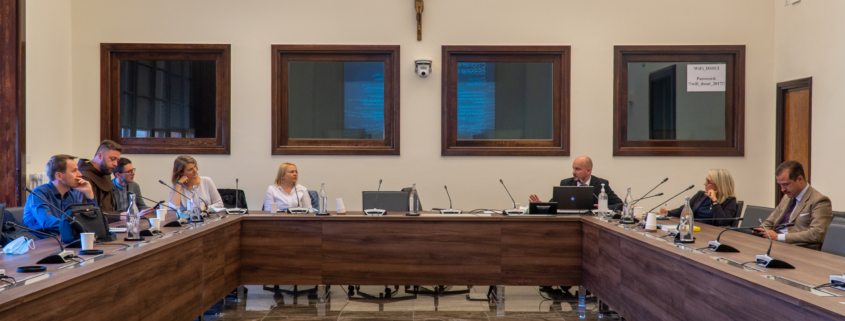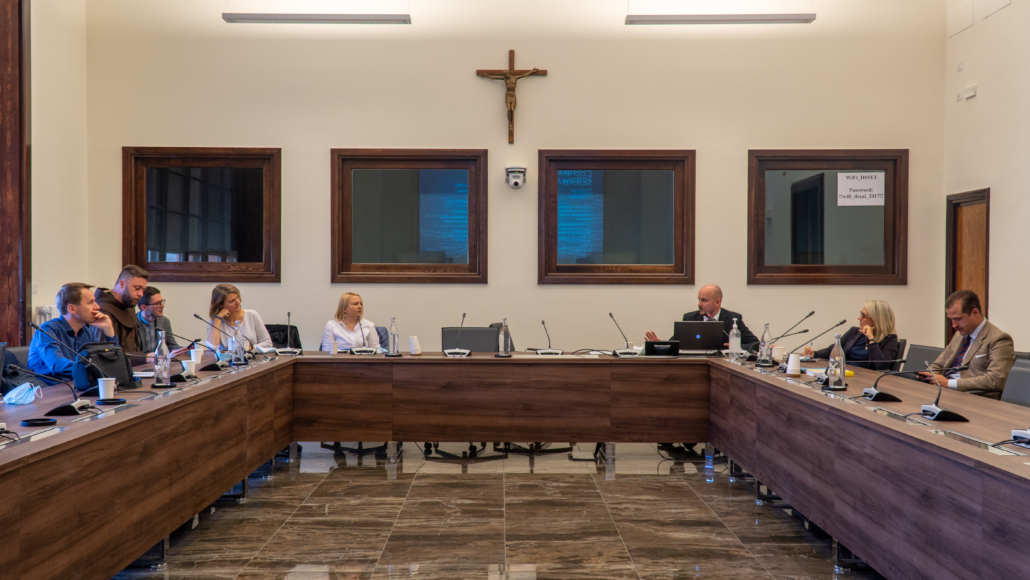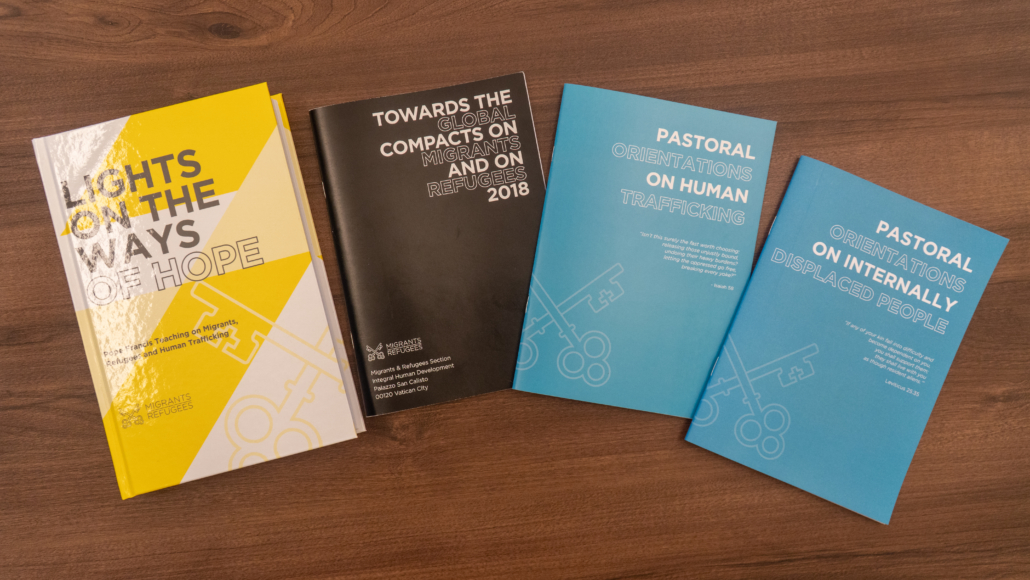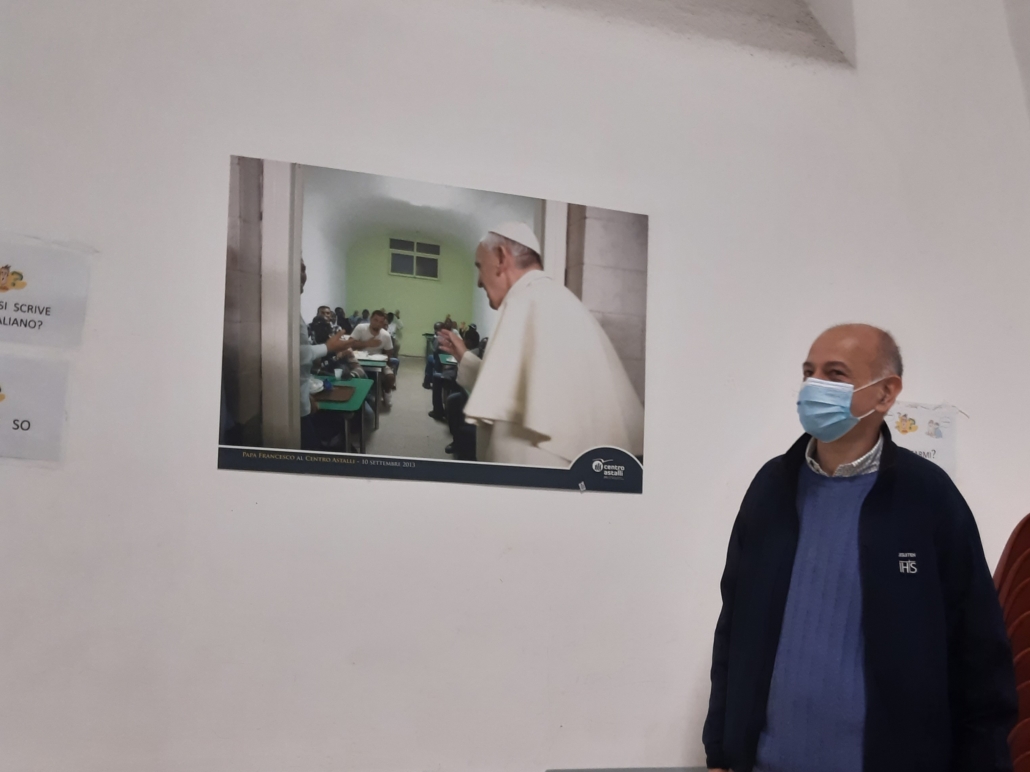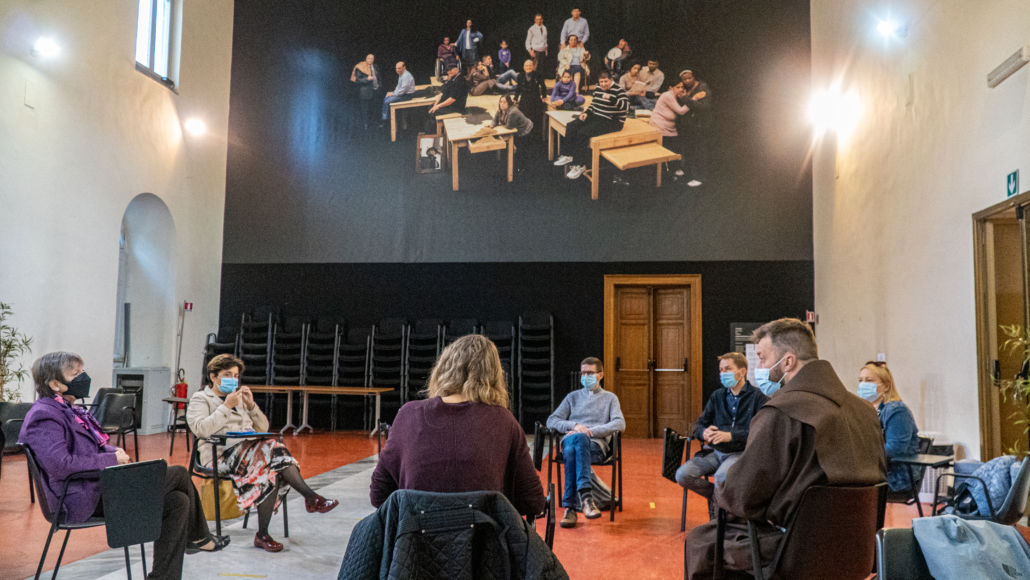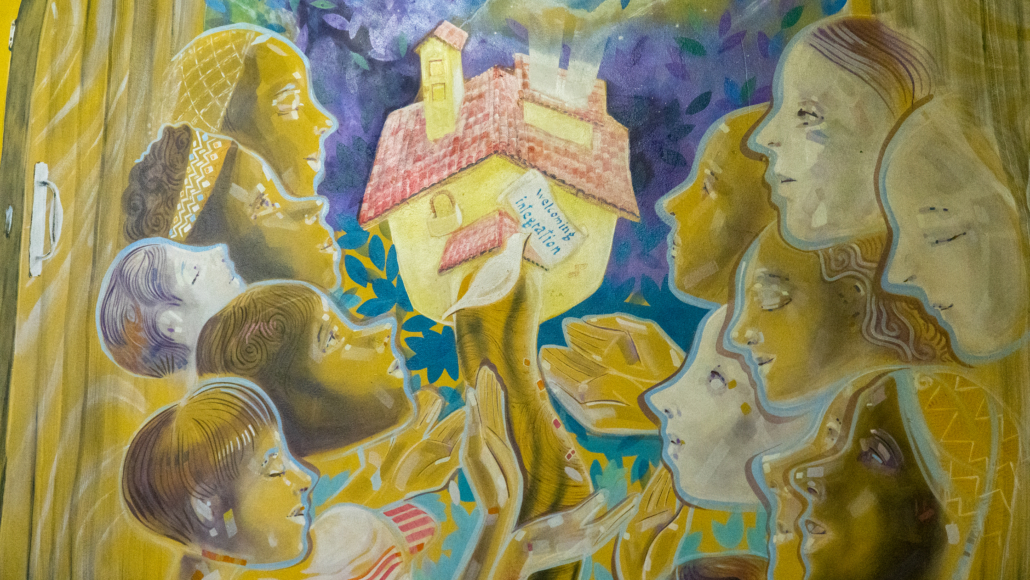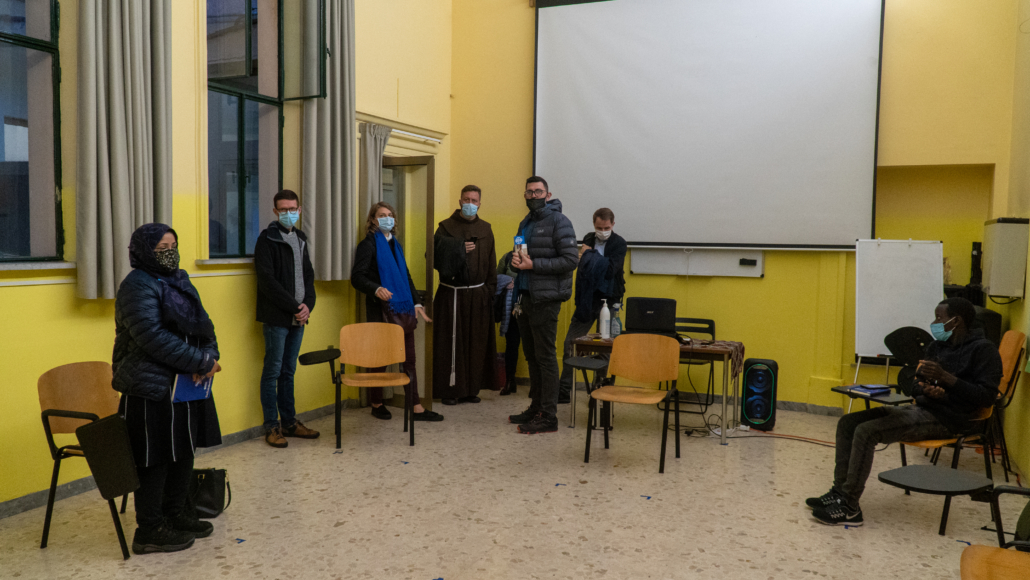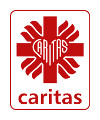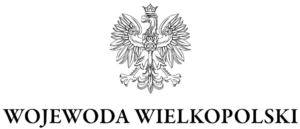04.01.2021 – Report on the study visit
From 12 to 16 October 2020, the representatives of Caritas Polska held a study visit in Rome. The aim of the trip was to gather information, share experiences and good practices with institutions that have been involved in helping migrants and refugees in Italy for many years. The leading theme of the visit was the social involvement of citizens and grassroots initiatives addressed to migrants, with particular emphasis on volunteers involved in the integration of foreigners.
Dicastery for Integral Human Development
The first steps during the visit were taken by the participants to the Dicastery for Integral Human Development, which was established in 2016 by Pope Francis. The Dicastery is responsible for social issues concerning people in need, the sick, victims of armed conflict, migrants and refugees. The meeting was held with representatives of the section for refugees and migrants, which is personally headed by Pope Francis. The situation of migrants and refugees is given priority during the current pontificate.
Meeting with representatives of the Dicastery on the role of Poland in a changing world. On the left, a delegation from Caritas Polska; on the right, employees of the Dicastery section for refugees and migrants
During a meeting between representatives of Caritas Polska and employees and members of the Dicastery for Integral Human Development, the basic principle that the Catholic Church follows in relation to migrants was presented. This is the so-called 4 verbs principle – welcome, protect, promote and integrate. It was formulated in opposition to the often encountered attitude of rejection, when we see in another person not a person worthy of attention, but a rival or someone who needs to be shaped according to our expectations.
During the conversation with representatives of the Dicastery, the role of the Vatican institution as an intermediary and advocate for these people, representing them before national and international organisations, was emphasised. Such actions must be promoted, but at the same time they must be presented transparently in order to build a sense of security in the host society. The final step is integration, which must not consist of assimilation or incorporation, but of mutual recognition of the richness that each person brings with their culture and experiences.
Publications by the Dicastery for Integral Human Development
Jesuit Astalli Centre
” The one who, like you, has fled from his land because of oppression, war, a nature distorted by pollution and desertification, or the unjust distribution of the planet’s resources, is a brother with whom you must share your bread, your home, your life. Forgive the closure and indifference of our societies that fear the change of life and mentality that your presence requires. Treated as a burden, a problem, a cost, you are instead a gift,” Pope Francis said last May at the Jesuit-run Astalli Centre in Rome
The Astalli Centre run by the Jesuit Order operates in a comprehensive and professional manner. Hot meals, shelter, legal aid and medical care are provided daily to people in difficult situations. The advantage of the Centre is its location in the very centre of Rome, which is crucial for the recipients of help. The Astalli Centre is located near the famous Church of Il Gesu, built on the initiative of the founder of the Order, Saint Ignatius Loyola.
Another important element of the Centre’s work is the involvement of volunteers, of whom there are about 300, who very often become refugees themselves and who, at the beginning of their presence in Italy, were the recipients of the Centre’s assistance.
The Astalli Centre places great emphasis on education, above all the learning of the Italian language and culture by migrants. This is the basis for successful integration into society. A very important part of the Jesuits’ activity is the education of the host society, especially with regard to the youngest, so regular workshops and projects are carried out in Roman schools. The Centre also provides a place of prayer for people believing in different religions.
Pictures of migrants placed on the walls of the Astalli Centre are part of ongoing educational campaigns
The Astalli Centre in Rome is part of a worldwide network of Jesuit Refugee Service (JRS) organisations whose mission is to accompany and advocate for refugees and relocated people.
Sant’Egidio
Today, the Sant’Egidio Movement is one of the most active in favour of the excluded and the needy. At present, there are about 5 million legal migrants in Italy, whom the organisation also helps to integrate by developing professional Italian language textbooks, helping them to obtain the right of residence, explaining how the health service works, how to behave in government offices and other state institutions. Vocational and language courses are provided, leading to state-recognised certificates. There are publications about this particular group in society.
The Sant’Egidio seat. In one of the rooms, there is a photo of the art installation that Anton Roca created for the 150th anniversary of Italian unification. It symbolises unity and a break with cultural prejudices. The artist arranged tables with fragments of a map of the country, and symbolic objects were placed in drawers. People representing various social groups, including the disabled, migrants, Roma, seniors, are sitting or standing next to the tables.
Food is provided on a daily basis. Migrants are usually assisted for about six months to continue living independently. Volunteers who have received special training are often involved in these initiatives. In this organisation, it is also not uncommon for former beneficiaries to become volunteers.
The long-term educational work and advocacy carried out by Sant’Egidio has been successful in changing social mentality. There are trainings for migrants about life in Italy or tutoring for children. Volunteers also give classes in schools about migration. Usually these meetings take place with migrants who tell their stories in schools. Assistance is also provided in finding employment. They pay a lot of attention to single mothers, the elderly or sick people.
The movement’s educational activities also involve, for example, monitoring the media and clarifying false information related to migrants, but also promoting the positive contribution of migrants to the Italian economy.
The campaigns that have been conducted, although they are often long-lasting, have also entailed changes in the law on migration. It is interesting to note that there are nearly 60 million people living in Italy and more than twice that number emigrating, so it is a migratory nation and perhaps that is why it is easier for Italians to welcome foreigners.
Casa Scalabrini 634
Mural on the wall of the Casa Scalabrini centre building created by migrants – a Muslim, a Christian and a Buddhist – symbolising the journey towards a safe home
A good example of a community working at the grassroots level to integrate migrants and refugees is Casa Scalabrini 634, run by ASCS (Scalabrinian Agency for Development Cooperation), supported by the Congregation of the Missionaries of St. Charles – Scalabriniani, which has been serving migrants for 130 years. In the framework of this initiative, shelter homes are run all over Italy. The programme follows the 4 verbs principle mentioned above, and its motto is: “It is not only about migrants, but about all of us”. In the house visited during the visit there are 34 adults, with legal residence status, who work and pay a symbolic 50 euro/month for housing.
In the Casa Scalabrini 634 house, 34 adult migrants and refugees live every day
The period of living at Casa Scalabrini 634 is a lesson in integration, showing that making a new life for oneself requires effort, a certain investment. Before being accepted into the house, one has to accept the rules, including such basic ones as the prohibition of alcohol and drugs, but also cleaning up after oneself and cooking. Living is possible for one year and the calendar is filled with activities to improve their skills to live in European society. The basis is learning the Italian language and culture, but there are also sports and recreational activities. It is a special time for every resident. Everyone is accepted and meets people to whom they can turn in the future in case of problems. For many, this safety cushion means a lot – it makes them feel safer and gives them hope for the future.
At Casa Scalabrini 634 one can find, among other things, a meeting room, a children’s room, a kitchen, a storeroom with a designated space for each resident’s products, a place for prayer or a gym.
Meeting room at Casa Scalabrini 634
Casa Scalabrini spreads this beautiful idea through its own internet radio “On the Move”, which the staff and volunteers of the centre run together with the residents. Its programmes can be listened to at www.onthemoveradio.it. In this simple way, migrants are given the opportunity to share their stories, telling of unusual places, rich cultures, traditions, difficult social and political realities and causes of conflicts.
On the Move radio gives the possibility to listen to programmes about the history of migrants, among other things
The Scalabrini also conduct educational activities in schools, where students can learn the stories of refugee migrants and see that they are people with the same dreams and hopes.
The home also offers a range of practical activities, such as sewing classes, where the residents of the home and others make costumes, e.g. for various performances or utility items
It is to be expected that migration will remain one of the key social issues in the world for a long time to come, with advancing climate change, social inequalities and armed conflicts pushing millions of people out of their current places of residence. This is undoubtedly a difficult test for the entire international community.
It is also important to remember that integration is always a two-way process that requires the willingness and cooperation of both sides in order to succeed. There is certainly no shortage of enormous challenges on this path, as can be seen by following the many years of activity of the Italian organisations mentioned.
An account of the study visit was also included in the Caritas Polska quarterly journal, published in December 2020:


